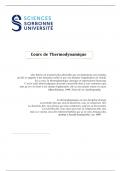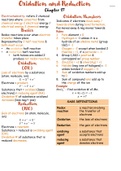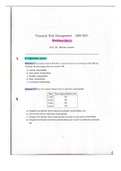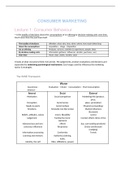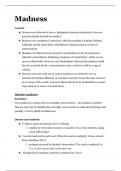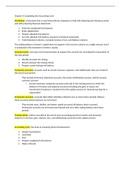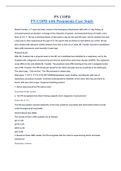When analyzing a student progress monitoring graph, the teacher could adapt an intensive intervention
plan if?
a. The students progress monitoring data (last four data points) is above the goal line and has been
collected for at least two weeks.
b. The students progress monitoring data (last four data points) is below the goal line and has been
collected for at least 15 days.
c. The students progress monitoring data (last four data points) is below the goal line and has been
collected for at least 6 weeks. - answer-c. The students progress monitoring data (last four data points)
is below the goal line and has been collected for at least 6 weeks.
When planning for the progress monitoring of a student with a suspected learning disability teacher
should ensure that?
a. The measurement is based on the curriculum and grade level for the suspected learning disability.
b. The learning environment is beneficial to the student.
c. The classroom teachers are highly qualified.
d. The student has been placed in the classroom. - answer-a. The measurement is based on the
curriculum and grade level for the suspected learning disability.
Effective progress monitoring includes?
a. Data from Tier 3 only.
b. A measure that is difficult to administer and interpret.
c. A single source to inform instructional decision-making for a student.
d. Data collected frequently enough to inform instructional and tier placement decisions. - answer-d.
Data collected frequently enough to inform instructional and tier placement decisions.
What conclusion can be made from analyzing the progress monitoring data for the student in the above
graph using the four-point method? (Image reflects last four data points under the benchmark)
a. The data indicates the student has not met the benchmark, the instruction/intervention is effective,
and an instructional change is not needed.
b. The data indicates the student met the benchmark, the instruction/intervention is not effective, and
an instruction change is needed.
c. The data indicates the student has not met the benchmark, the instruction/intervention is not
effective, and an instructional change is not needed.
d. The data indicates the student has not met the benchmark, the instruction/intervention is not
effective, and an instructional change is needed. - answer-d. The data indicates the student has not met
the benchmark, the instruction/intervention is not effective, and an instructional change is needed.
What conclusion can be made from analyzing the progress monitoring data for the student in the above
graph using the four-point method? (Image reflects all data points are above the benchmark)
a. The data indicates the student met the benchmark, the instruction/intervention is not effective, and
an instruction change is needed.
b. The data indicates the student has met the benchmark, the instruction/intervention is effective, and
an instructional change is not needed.
c. The data indicates the student has not met the benchmark, the instruction/intervention is not
effective, and an instructional change is not needed.
, d. The data indicates the student has not met the benchmark, the instruction/intervention is not
effective, and an instructional change is needed. - answer-b. The data indicates the student has met the
benchmark, the instruction/intervention is effective, and an instructional change is not needed.
What conclusion can be made from analyzing the progress monitoring data for the student in the above
graph using the four-point method? (Image reflects last four data points far exceeding the benchmark)
a. The data indicates the student has met the benchmark, the instruction/intervention is effective, an
instructional change is not needed, and the teacher should consider a more challenging goal.
b. The data indicates the student met the benchmark, the instruction/intervention is not effective, an
instruction change is needed, and the teacher should not consider a more challenging goal.
c. The data indicates the student has not met the benchmark, the instruction/intervention is not
effective, an instructional change is not needed, and the teacher should not consider a more challenging
goal. - answer-a. The data indicates the student has met the benchmark, the instruction/intervention is
effective, an instructional change is not needed, and the teacher should consider a more challenging
goal.
What conclusion can be made from analyzing the progress monitoring data for the student in the above
graph using the four-point method? (Image reflects two data points on the benchmark, one above it,
and one below the benchmark)
a. The data indicates the student met the benchmark, the instruction/intervention is not effective, and
an instruction change is needed.
b. The data indicates the student has met the benchmark, the instruction/intervention is effective, and
an instructional change is not needed.
c. The data indicates the student has not met the benchmark, the instruction/intervention is not
effective, and an instructional change is not needed.
d. The data indicates the student has not met the benchmark, the instruction/intervention is not
effective, and an instructional change is needed. - answer-b. The data indicates the student has met the
benchmark, the instruction/intervention is effective, and an instructional change is not needed.
These are the results of Moe's passage reading fluency probe. Which common reading error does Moe
most often make, based on error analysis of his passage reading fluency probe? (Image shows Moe
pronounced the words: state as stat, drove as drov, time as tim, drive as driv, games as gams, etc.)
a. Long vowels/silent e
b. Vowel teams
c. Substitutions
d. Omissions - answer-a. Long vowels/silent e
During his RFP, Joshua read 149 words. He misread 14 words, added one word, and omitted three
words. What is Joshua's reading score?
a. 149 words read correctly
b. 148 words read correctly
c. 146 words read correctly
d. 131 words read correctly - answer-d. 131 words read correctly
Which common computational error does Omar most often make, based on error analysis of his
mathematics probe? (The image reflects Omar added the problems that were asking him to subtract.)
a. Omar does not know basic number facts. He is unable to add or subtract.


